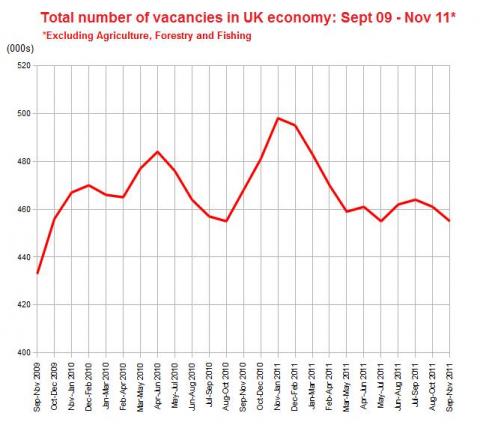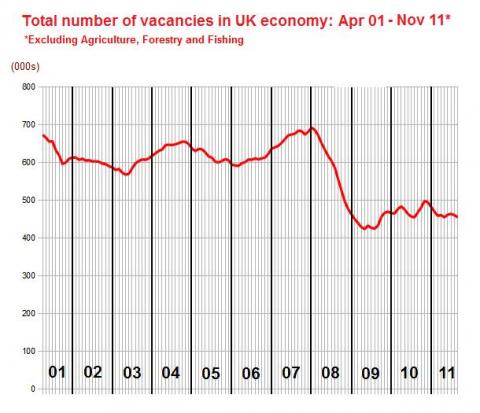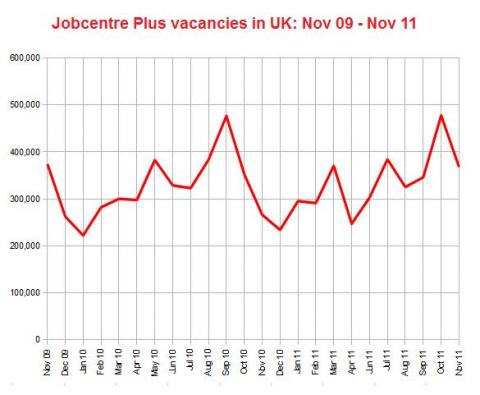Are job vacancies at their highest level for two years?
"Job vacancies are at their highest level for two years, figures revealed yesterday."
"Official statistics show they are up by a whopping 20 per cent overall — with a total of 450,000 jobs available across the UK."
The Sun, 6 January 2012
This morning the Sun ran a story with figures suggesting that the number of job vacancies in the UK had reached their highest total for two years.
It claimed that 450,000 jobs are avaiable across the UK, with vacancies rising most sharply in London, up by 29 per cent since 2009.
So is this some good news in the economic gloom? Full Fact went in search of the original figures.
Analysis
The Sun appeared to be the only major outlet reporting the story, but did not clearly indicate where the figures came from.
The Office for National Statistics (ONS), however, regularly publishes Labour Market Statistics, the most recent of which were released on 14 December last year.
In their statistical release and data table, they show that, from September to Novermber 2011, the total estimate for the number of vacancies in the economy was 455,000.
On the face of it, this seems to verify one of the Sun's figures. But is this the highest recorded level for two years? The ONS statistics suggest otherwise:

Taking data from the last two years, the number of job vacanices in the economy is actually at one of its lowest levels since November 2009, considerably lower than the peak of approximately 498,000 from November 2010 to January 2011.

Since the Sun's headline paints a completely different picture, it seems likely they were looking at different statistics.
In fact, there are two ways of measuring job vacancies in the UK. One is by using conventional ONS Labour Market Statistics, the other is using vacancy data compiled by Jobcentre Plus.
As a technical report from the Department or Work and Pensions (DWP) makes clear, the distinction between these two measurements is highly significant.
The ONS statistics are gathered by means of survey, and apply to the whole economy. Meanwhile, the Jobcentre Plus statistics are drawn directly from the Jobcentre database of vacanices in various areas.
Examining figures from this database revealed the total number of Jobcentre vacancies in November last year stood at 368,162 jobs. The data measured the numbers monthly rather than in the three-month windows used by the ONS, hence the two datasets are not directly comparable.

Some of the historical estimates seemed closer to the Sun's report, however. The "20 per cent" rise is approximately correct when comparing September to November 2011 with the same months two years ago in 2009. Again, the Sun report gives few clues as to their methodology so this too is difficult to verify.
However, even with the use of this measure, the current 368,162 is not the highest recent figure, nor are the last three months' figures combined. August to November 2010 saw higher three-month totals and a much higher figure for October.
Hence, there is still no evidence that the current number of vacancies is at its highest level for two years as the Sun claims.
In addition, the very use of the Jobcentre figures as a proxy for vacancies in the UK is questionable.
A contact from the DWP made clear that, while the Jobcentre statistics are much more precise as they are drawn directly from administrative databases, they are limited in that they only show those jobs that are actually being advertised by the Jobcentre Plus.
The ONS statistics, meanwhile, are much less precise since they are drawn from surveys, but they do apply to the whole economy rather than job centres alone.
Conclusion
Given that the Sun's 450,000 figure most closely correlates with ONS data, while their regional and historical data matches Jobcentre Plus figures, the newspaper appears to be using both measures interchangeably.
This is potentially problematic as there is no indication or information given in the article as to the sources of the figures. Hence readers of the piece could be faced with a confusing picture of how many jobs are actually available in the economy and how these figures have trended over the last two years.
Needless to say, Full Fact has contacted the Sun to ask for information regarding the source of the figures, and we will update when we recieve a reply.